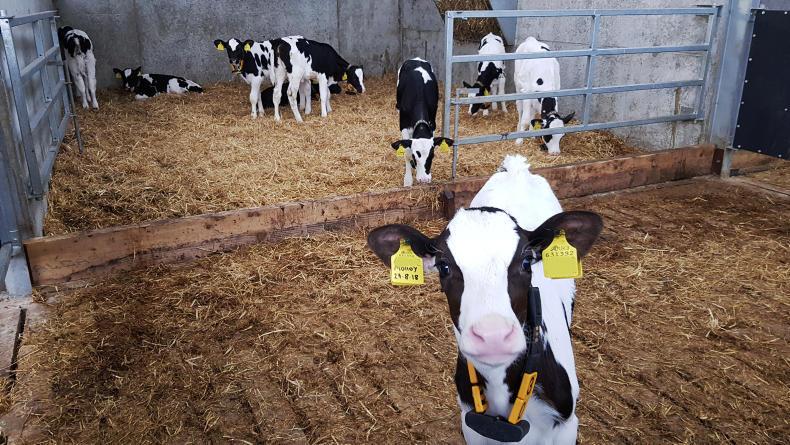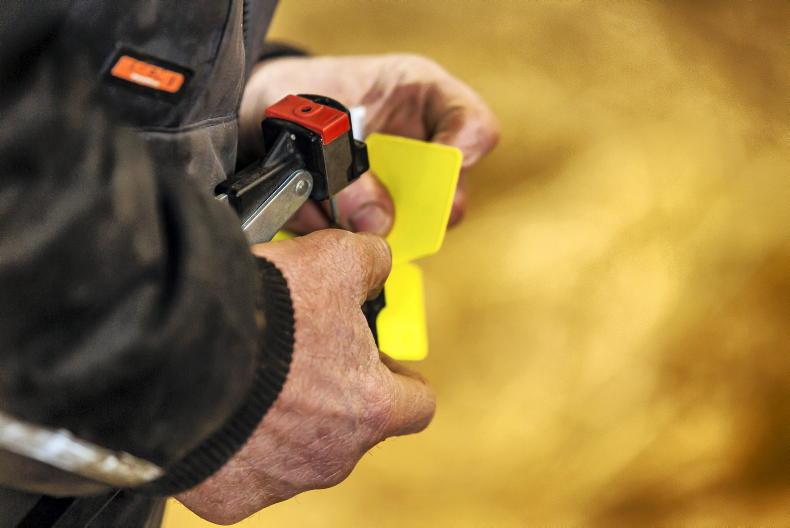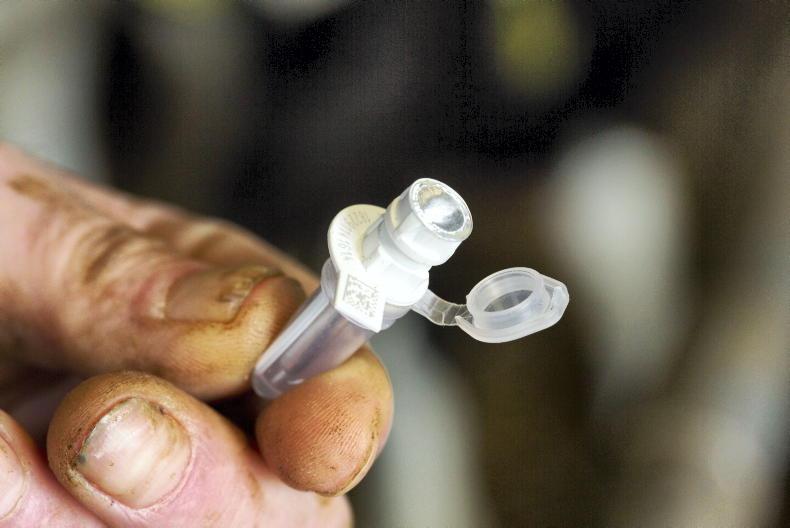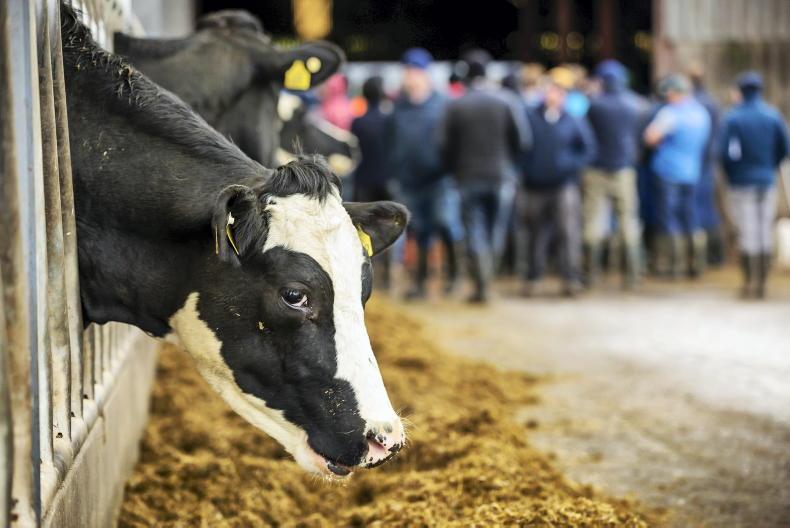The first calves born on Dairylink Ireland programme farms this autumn are now over 10 weeks of age and are being weaned off milk at 85-100kg liveweight.
The focus from now on with these calves is to keep growth rates pushing on over the winter so that calves are 175-200kg liveweight when they are going to grass in the spring.
The plan to achieve this is to front-load concentrates to calves early on so that heifers can go on grass-only diets if liveweights are on target in the summer. This is important because an aim for several phase two programme participants is to reduce concentrate feeding, including meal fed to heifers.
Dairylink Ireland adviser Conail Keown said that feeding 0.5t of concentrates per heifer over the rearing process should be achievable by most programme farmers.
Dairylink participants will be monitoring liveweights and growth rates through periodic weighing of heifers on electronic scales. A lower-cost option for monitoring heifer weights is a weigh band which is fairly accurate at matching shoulder widths to liveweights.

The new shed has an open front, with windbreaks on rollers.
The aim is to achieve steady growth after weaning at a daily liveweight gain of 0.8kg, or around 25kg per month. The main target is to reach 60% of mature liveweights, which is generally 360-390kg, for breeding at 14-15 months of age and calving by 24 months.
Later-born calves may be fed more concentrates to hit liveweight targets at younger ages so that breeding and calving takes place at the same time as the rest of the replacement heifers.
Developing a compact calving profile allows a more uniform bunch of heifer calves throughout the rearing process. This means easier management of heifers and reduces the need to feed later-born calves extra meal to catch up with the rest of the group.
Weekly roundup
The first autumn-born calves are being weaned on Dairylink farms at present.Young calves are offered concentrates and straw for rumen development.Weaned calves are being fed concentrates and silage and target DLWG is 0.8kg.Pre-breeding heat detection is ongoing ahead of the start of breeding at the end of the month.Farmer focus: Richard Marshall, Omagh, Co Tyrone
A new calf shed was completed on Richard and John Marshall’s farm near Omagh earlier this year and the first calves went into it at the start of calving in early September.
Calving on the Marshall farm will be ongoing until March and, although the biggest burst is past, a few new calves are entering the shed each week.
The new five-bay shed contains five group pens with 10 to 12 calves and an automatic feeder in each pen. Calves have EID collars and readers on the feeder record individual intakes. Calves are on a feed plan which builds intakes up to 6.5 litres and then gradually brings them down over two weeks for weaning.
Richard said that there has been a lot less noise from calves at weaning this year and the new shed has also reduced labour demand with calf rearing.
He said that this is a significant change from last year as an existing calf shed had to be demolished to make way for the new one which meant calves had to be housed in various other sheds and there was a substantial labour requirement for feeding and bedding.
The shed on the Marshall farm has an open front with windbreaks on rollers at the top of each bay. At the back of the shed, there are fixed windbreaks running from the top of the wall to the roof.
There is a raised ridge on the roof of the shed to improve ventilation by facilitating air movement. A positive pressure tube was also installed in the shed for increased air movement.
Calves have access to deep straw bedding at the back of each pen and the front half is concrete slats. Straw is available to calves in racks and calf nuts are offered ad lib at the front of each pen in troughs for early rumen development. Calves have unrestricted access to water in bowl drinkers beside each automatic feeder.
The oldest calves have now been weaned and will be moved to an existing cubicle shed shortly where they will be transitioned from nuts to a blend and will be fed baled silage with access to straw in racks.
There are around 40 calves on the ground so there has not been a rush to get calves out of the new shed as space is not an issue. A TB breakdown meant there are fewer calves and freshly calved heifers and cows than planned on the Marshall farm this autumn. However, freshly calved heifers are now being bought in to build numbers up again.
Cows were housed full-time on the Marshall farm at the start of last week. The milking herd is on a total mixed ration of first-cut silage, 5kg of a 17% crude protein blend, 0.5kg of straw nuts and 300g of Megalac. Cows are then fed to yield in the parlour with the average parlour feed rate standing at 3.5kg/cow/day at present.
Read more
Dairylink : options for dry cows on project farms
Watch: grazing finishing up on Dairylink farms
The first calves born on Dairylink Ireland programme farms this autumn are now over 10 weeks of age and are being weaned off milk at 85-100kg liveweight.
The focus from now on with these calves is to keep growth rates pushing on over the winter so that calves are 175-200kg liveweight when they are going to grass in the spring.
The plan to achieve this is to front-load concentrates to calves early on so that heifers can go on grass-only diets if liveweights are on target in the summer. This is important because an aim for several phase two programme participants is to reduce concentrate feeding, including meal fed to heifers.
Dairylink Ireland adviser Conail Keown said that feeding 0.5t of concentrates per heifer over the rearing process should be achievable by most programme farmers.
Dairylink participants will be monitoring liveweights and growth rates through periodic weighing of heifers on electronic scales. A lower-cost option for monitoring heifer weights is a weigh band which is fairly accurate at matching shoulder widths to liveweights.

The new shed has an open front, with windbreaks on rollers.
The aim is to achieve steady growth after weaning at a daily liveweight gain of 0.8kg, or around 25kg per month. The main target is to reach 60% of mature liveweights, which is generally 360-390kg, for breeding at 14-15 months of age and calving by 24 months.
Later-born calves may be fed more concentrates to hit liveweight targets at younger ages so that breeding and calving takes place at the same time as the rest of the replacement heifers.
Developing a compact calving profile allows a more uniform bunch of heifer calves throughout the rearing process. This means easier management of heifers and reduces the need to feed later-born calves extra meal to catch up with the rest of the group.
Weekly roundup
The first autumn-born calves are being weaned on Dairylink farms at present.Young calves are offered concentrates and straw for rumen development.Weaned calves are being fed concentrates and silage and target DLWG is 0.8kg.Pre-breeding heat detection is ongoing ahead of the start of breeding at the end of the month.Farmer focus: Richard Marshall, Omagh, Co Tyrone
A new calf shed was completed on Richard and John Marshall’s farm near Omagh earlier this year and the first calves went into it at the start of calving in early September.
Calving on the Marshall farm will be ongoing until March and, although the biggest burst is past, a few new calves are entering the shed each week.
The new five-bay shed contains five group pens with 10 to 12 calves and an automatic feeder in each pen. Calves have EID collars and readers on the feeder record individual intakes. Calves are on a feed plan which builds intakes up to 6.5 litres and then gradually brings them down over two weeks for weaning.
Richard said that there has been a lot less noise from calves at weaning this year and the new shed has also reduced labour demand with calf rearing.
He said that this is a significant change from last year as an existing calf shed had to be demolished to make way for the new one which meant calves had to be housed in various other sheds and there was a substantial labour requirement for feeding and bedding.
The shed on the Marshall farm has an open front with windbreaks on rollers at the top of each bay. At the back of the shed, there are fixed windbreaks running from the top of the wall to the roof.
There is a raised ridge on the roof of the shed to improve ventilation by facilitating air movement. A positive pressure tube was also installed in the shed for increased air movement.
Calves have access to deep straw bedding at the back of each pen and the front half is concrete slats. Straw is available to calves in racks and calf nuts are offered ad lib at the front of each pen in troughs for early rumen development. Calves have unrestricted access to water in bowl drinkers beside each automatic feeder.
The oldest calves have now been weaned and will be moved to an existing cubicle shed shortly where they will be transitioned from nuts to a blend and will be fed baled silage with access to straw in racks.
There are around 40 calves on the ground so there has not been a rush to get calves out of the new shed as space is not an issue. A TB breakdown meant there are fewer calves and freshly calved heifers and cows than planned on the Marshall farm this autumn. However, freshly calved heifers are now being bought in to build numbers up again.
Cows were housed full-time on the Marshall farm at the start of last week. The milking herd is on a total mixed ration of first-cut silage, 5kg of a 17% crude protein blend, 0.5kg of straw nuts and 300g of Megalac. Cows are then fed to yield in the parlour with the average parlour feed rate standing at 3.5kg/cow/day at present.
Read more
Dairylink : options for dry cows on project farms
Watch: grazing finishing up on Dairylink farms











SHARING OPTIONS